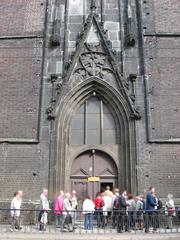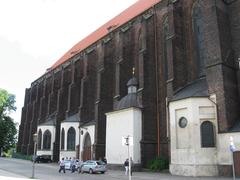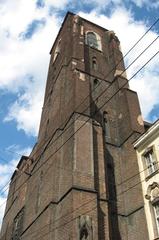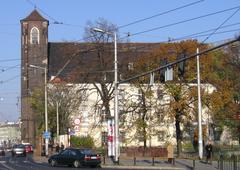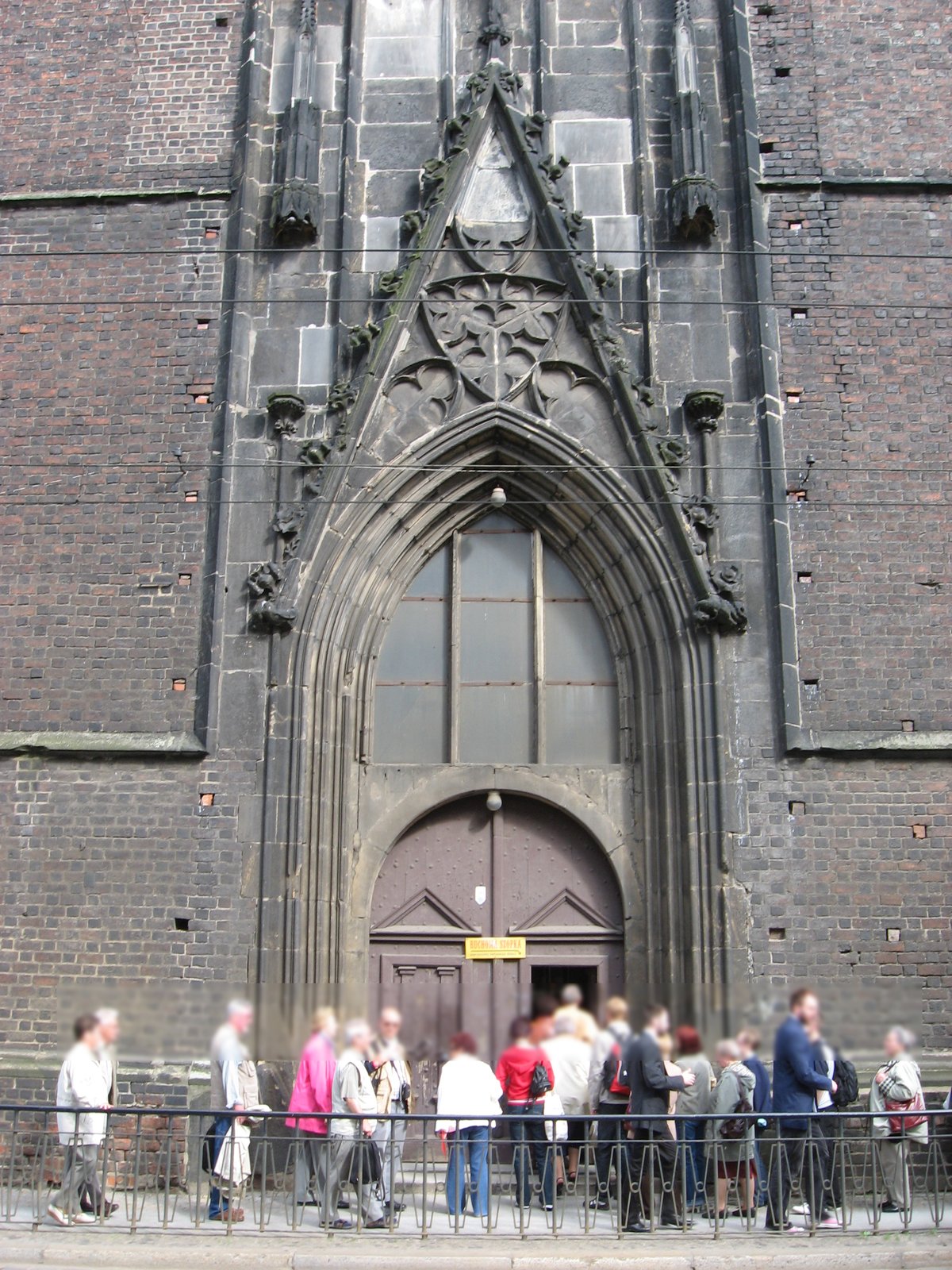
Saint Maria Of The Sand: Visiting Hours, Tickets & Historical Sites in Wrocław
Date: 14/06/2025
Introduction
Situated on Piasek Island in the heart of Wrocław, Poland, the Church of Saint Maria Of The Sand (Kościół Najświętszej Marii Panny na Piasku) is a remarkable testament to the city’s enduring spiritual, architectural, and cultural heritage. Founded in the early 12th century, the church has weathered centuries of social change, destruction, and renewal, and today stands as a vibrant place of worship, a center for cultural events, and a must-see landmark for visitors to Wrocław.
This guide provides an in-depth look at the church’s historical development, architectural and artistic features, practical visiting information—including hours, tickets, accessibility, and tours—as well as tips for exploring nearby attractions. Whether your interest is history, architecture, spirituality, or immersive travel, Saint Maria Of The Sand offers a richly rewarding experience.
Table of Contents
- Historical Overview
- Architectural and Artistic Significance
- Visiting Information
- Nearby Attractions & Travel Tips
- Visitor Experience & Practical Tips
- FAQ
- Conclusion
- References
Historical Overview
Origins and Early Development
The Church of Saint Maria Of The Sand traces its origins back to the early 12th century. Founded by Piotr Włostowicz and his wife Maria, the site first hosted an Augustinian monastery and a Romanesque church dedicated to the Virgin Mary. The Romanesque tympanum from this period, depicting the Virgin with the founders, is one of the most important pieces of early Polish sculpture (napiasku.org). The church quickly became a focal point of religious life in medieval Wrocław.
Gothic Transformation and Turbulent Centuries
In the 14th century, the growing congregation necessitated a larger structure, leading to the construction of a grand Gothic hall church. Consecrated in 1365, it featured hallmark elements of Silesian Gothic: brick walls, ribbed vaults, tall windows, and a spacious nave. The church’s Latin name, Sancta Maria in Arena, and its Polish name, referencing “sand,” both reflect its location on Piasek Island (Wikipedia).
Through the centuries, the church was shaped by the shifting tides of Central European history. It experienced periods of prosperity and hardship, including the devastation of the 1945 Siege of Wrocław, which left the building gutted by fire and looting. Restoration efforts after World War II, lasting from 1946 to 1966, painstakingly revived its former glory, integrating rescued artworks and new stained glass (medievalheritage.eu).
Religious and Cultural Significance
Dedicated to the Virgin Mary, the church is a center of Marian devotion and a living witness to Wrocław’s multicultural heritage. Over the centuries, it has welcomed diverse communities—Polish, German, Czech, and Jewish—and its post-war restoration stands as a symbol of reconciliation and resilience (enrs.eu). Today, it continues to host religious services, concerts, and civic events.
Architectural and Artistic Significance
Romanesque Foundations
The original Romanesque church, established by the Augustinian canons, was notable for its thick walls, rounded arches, and small windows. The surviving tympanum in the south aisle is an outstanding example of Romanesque art in Poland (lonelyplanet.com).
Gothic Splendor
The current church, begun in 1334, showcases the best of Silesian Gothic architecture: lofty brick facades, tall pointed arches, ribbed vaults, and large stained glass windows. The main portal is intricately decorated, and the overall effect is one of spaciousness and upward movement.
Artistic Heritage
- Triptychs and Altarpieces: The interior houses Gothic and Renaissance altarpieces depicting scenes from the life of Mary and Christ.
- Stained Glass: Modern replacements, created by Teresa Reklewska, flood the nave with color and light, evoking the medieval ambiance.
- Mechanised Nativity Scene (Szopka): A unique animated nativity display, activated by donation, delights visitors year-round.
- Tomb Monuments: Over 100 tombs of notable Wrocław citizens highlight the church’s historical importance.
- Organ and Concerts: The church’s organs are noted for their acoustics, and regular concerts are held in the sacred space.
Visiting Information
Opening Hours
- Monday–Friday: 9:00 AM – 6:00 PM
- Saturday: 10:00 AM – 4:00 PM
- Sunday: 12:00 PM – 6:00 PM
Hours may vary during religious holidays and special events. Please check the official website or local tourist information for current schedules.
Admission & Tickets
- Main Church Area: Admission is free. Donations are appreciated.
- Special Features: A small fee (approx. 10 PLN) may apply for tourists or special exhibits.
- Bridge of Penitents: Separate ticket required (see section below).
Guided Tours
- Languages: Polish, English, and others upon request.
- Booking: In advance via the parish office, official website, or at the entrance.
- Audio Guides: Available for self-paced visits (audiala.com).
Accessibility
- Main Floor: Wheelchair accessible with ramps and designated areas.
- Bridge of Penitents: Accessed by 247 steps; not wheelchair accessible.
- Assistance: Contact in advance for special needs support (wroclawexplorer.com).
Photography
- Permitted: Yes, except during services or events. Flash and tripods may be restricted.
Nearby Attractions & Travel Tips
Must-See Neighbors
- Wrocław Market Square (Rynek): Poland’s second-largest medieval market square, a vibrant hub of cafes, shops, and the historic Town Hall.
- Cathedral Island (Ostrów Tumski): Home to the Cathedral of St. John the Baptist and picturesque gas lamps.
- Tumski Bridge: The “Lovers’ Bridge,” connecting Sand Island to Cathedral Island.
- Botanical Garden: A short walk away, perfect for a tranquil break.
- Antiques Market: Held nearby, offering unique local finds (happylittletraveler.com).
Getting There
- Location: ul. Szewska 10, 50-122 Wrocław, central Old Town.
- Public Transport: Trams and buses stop at Plac Dominikański or Galeria Dominikańska.
- Parking: Paid lots nearby; spaces can be limited during peak hours (visitwroclaw.eu).
Travel Tips
- Best Times: Early mornings or late afternoons on weekdays offer a quieter experience.
- Dress Code: Shoulders and knees covered; maintain silence during services.
- Safety: Wrocław is safe, but standard travel precautions apply.
- Facilities: Restrooms available onsite or nearby; plenty of cafes in the Old Town.
- Souvenirs: No church shop, but Old Town has many artisan and souvenir stores.
Visitor Experience & Practical Tips
The Main Nave & Interior
Marvel at soaring Gothic arches, luminous stained glass, and masterful stonework. The atmosphere is serene, with the 17th-century high altar and numerous side chapels inviting contemplation (audiala.com).
Bridge of Penitents (Mostek Pokutnic)
A highlight of the visit, this narrow bridge connects the twin towers 45 meters above the ground. Climb 247 steps for panoramic Old Town views and discover the local legend of penitent women. The vantage point is ideal for photography (happylittletraveler.com).
Events & Community Life
Saint Maria Of The Sand is an active center of worship and civic life, hosting regular masses, Marian feast processions, organ concerts, and cultural events. During emergencies, such as the 1997 flood, the church has served as a community refuge (enrs.eu).
FAQ
Q: What are the visiting hours?
A: Monday–Friday 9:00 AM–6:00 PM; Saturday 10:00 AM–4:00 PM; Sunday 12:00 PM–6:00 PM. Hours may change on holidays (audiala.com).
Q: Is there an entrance fee?
A: Entry to the main church is free. Special features or exhibits may require a small fee.
Q: How much does the Bridge of Penitents cost?
A: 18 PLN for adults; 12 PLN for students, seniors, and children (audiala.com).
Q: Is the church accessible for visitors with mobility impairments?
A: The main floor is accessible; the bridge is not.
Q: Are guided tours available?
A: Yes, in several languages. Book in advance or at the entrance.
Q: Is photography allowed?
A: Yes, except during services or events. Flash and tripods may be restricted.
Conclusion
The Church of Saint Maria Of The Sand embodies Wrocław’s layered history, artistic richness, and resilient spirit. From its Romanesque beginnings and Gothic grandeur to its post-war restoration, the church offers a unique window into the city’s multicultural past and vibrant present. Visitors are welcomed not only as guests but as participants in living traditions of faith, art, and community.
Plan your visit to this iconic landmark, enjoy panoramic city views from the Bridge of Penitents, and immerse yourself in the cultural heart of Wrocław. Combine your tour with nearby attractions for a comprehensive experience of the city’s historical treasures.
For more information and travel planning, consult:
References
- Kościół Najświętszej Marii Panny na Piasku, napiasku.org
- Church of St Mary on the Sand, medievalheritage.eu
- Church of St Mary on the Sand, Wikipedia
- Church of Our Lady on the Sand, Lonely Planet
- Famous Islands of Wrocław, meetmycity.tours
- Best Places in Wrocław, theplaceswherewego.com
- Wrocław in the History and Memory of Poles, enrs.eu
- Wrocław Tourist Information Centers, wroclawexplorer.com
- One Day in Wrocław, happylittletraveler.com
- Things You Should Know Before You Visit Wrocław, wroclawguide.com
- Visit Wrocław, visitwroclaw.eu
- Saint Maria Of The Sand Church Guide, audiala.com
